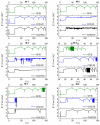Interaction of High Flash Point Electrolytes and PE-Based Separators for Li-Ion Batteries
- PMID: 26343636
- PMCID: PMC4613202
- DOI: 10.3390/ijms160920258
Interaction of High Flash Point Electrolytes and PE-Based Separators for Li-Ion Batteries
Abstract
In this study, promising electrolytes for use in Li-ion batteries are studied in terms of interacting and wetting polyethylene (PE) and particle-coated PE separators. The electrolytes are characterized according to their physicochemical properties, where the flow characteristics and the surface tension are of particular interest for electrolyte-separator interactions. The viscosity of the electrolytes is determined to be in a range of η = 4-400 mPa∙s and surface tension is finely graduated in a range of γL = 23.3-38.1 mN∙m(-1). It is verified that the technique of drop shape analysis can only be used in a limited matter to prove the interaction, uptake and penetration of electrolytes by separators. Cell testing of Li|NMC half cells reveals that those cell results cannot be inevitably deduced from physicochemical electrolyte properties as well as contact angle analysis. On the other hand, techniques are more suitable which detect liquid penetration into the interior of the separator. It is expected that the results can help fundamental researchers as well as users of novel electrolytes in current-day Li-ion battery technologies for developing and using novel material combinations.
Keywords: Li-ion battery; contact angle; electrolytes; safety; separators.
Figures











References
-
- Zhang S.S. A review on the separators of liquid electrolyte li-ion batteries. J. Power Sources. 2007;164:351–364. doi: 10.1016/j.jpowsour.2006.10.065. - DOI
-
- Fu Z., Feng H., Sun C., Xiang X., Wu W., Luo J., Hu Q., Feng A., Li W. Influence of solvent type on porosity structure and properties of polymer separator for the Li-ion batteries. J. Solid State Electrochem. 2013;17:2167–2172. doi: 10.1007/s10008-013-2072-9. - DOI
-
- Leitner K.W., Wolf H., Garsuch A., Chesneau F., Schulz-Dobrick M. Electroactive separator for high voltage graphite/lini0.5Mn1.5O4 lithium ion batteries. J. Power Sources. 2013;244:548–551. doi: 10.1016/j.jpowsour.2013.01.187. - DOI
-
- Sun Z-X., Zhang X., Huang B., Ma Y.-W. Effects of separator on the electrochemical performance of electrical double-layer capacitor and hybrid battery-supercapacitor. Acta Phys. Chim. Sin. 2014;30:485–491.
Publication types
MeSH terms
Substances
LinkOut - more resources
Full Text Sources
Other Literature Sources

